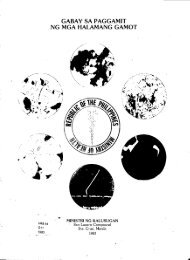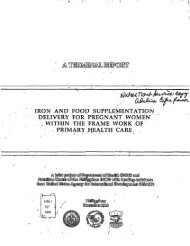ON FOOD fORTI - DOH Central Library - Department of Health
ON FOOD fORTI - DOH Central Library - Department of Health
ON FOOD fORTI - DOH Central Library - Department of Health
You also want an ePaper? Increase the reach of your titles
YUMPU automatically turns print PDFs into web optimized ePapers that Google loves.
30<br />
level but iodine is in the microgram level.<br />
The cost <strong>of</strong> the fortificant would be 0.1<br />
centavo per bottle and the preparation<br />
<strong>of</strong> the iodine solution and the addition<br />
to the fish sauce would be probablyaround<br />
10 to 25 centavos per bottle. Thus, the<br />
additional cost for the fortification would<br />
only amount to 10 to 25 centavos per<br />
bottle. In the manufacturing <strong>of</strong> fish<br />
sauce the first extract <strong>of</strong> fish sauce can<br />
also be diluted. The brine solution can<br />
be usedwith iodizedsaltspecially fortified<br />
at the level <strong>of</strong> 150 ug iodine per gram<br />
or 150 ppm. The iodized salt producers<br />
can do this fortification withan additional<br />
charge<strong>of</strong> probablyP 50.00persack, which<br />
will amount to an additional cost for<br />
fortification <strong>of</strong> only about 3 centavos per<br />
bottle at 1:1 dilution usinghighly fortified<br />
iodized saltfor the brinesolution. Diluting<br />
the first extract <strong>of</strong> the fish sauce will only<br />
add 3 centavos to the production cost.<br />
Even if the food manufacturer puts in<br />
an additional 5 centavos the consumer<br />
can easily afford that.<br />
On saltfortification, there are already<br />
17 iodization plants in the Philippines.<br />
Next week this will be 18. Salt iodization<br />
is an easy process whereby .the salt is<br />
sprayed with iodine at a certain level (we.<br />
are recommending 100 ppm potassium<br />
iodate or 60 ppm iodine).<br />
A Report on Food Fortification<br />
Double fortification <strong>of</strong> salt with iron'<br />
and iodine, as well as fortification <strong>of</strong> salt<br />
with iron has been done in India. The<br />
fortified products may already be in the<br />
market. Fortification <strong>of</strong> salt with iron<br />
uses ferrous sulfate stabilized with<br />
monosodium dihydrogen phosphate and<br />
sodium acid sulfate. Mix the first two<br />
compoundsbefore addingthe sodiumacid<br />
sulfate and then use the machine in<br />
fortifying with iodine, spraying the<br />
fortificant mixture on the salt, and you<br />
have an iron fortified salt. A technical<br />
problem encountered in double<br />
fortification <strong>of</strong> salt with iron and iodine<br />
was in the acidic nature<strong>of</strong> ironfortifica tion<br />
as well as in sodium acid sulfate. The<br />
wocesswill oxidize the iodide<strong>of</strong> or iodate<br />
to free iodine which will vaporize.<br />
Potassium iodateisalso an oxidizingagent,<br />
actually the fortificant used most in India<br />
as well as in the Philippines, which will<br />
cause oxidation <strong>of</strong> ferrous to ferric with<br />
a corresponding, decrease in<br />
bioavailability. Using other iron<br />
compounds develops a color formation<br />
and the hygroscopic nature <strong>of</strong> salt tends<br />
to oxidizeferrous to ferric sulfateshowing<br />
a high concentration <strong>of</strong> the iron fortificant<br />
as against the fortificant required for the<br />
iodine. In solving this technical problem,<br />
experiments showed that salt required<br />
for double fortification should almost he<br />
pure salt: 99% sodium chloride content,<br />
minimum magnesium, insoluble residue<br />
and moisture content. These are the salt<br />
specifications for double fortification. For<br />
the iron fortificant, ferrous fumarate








